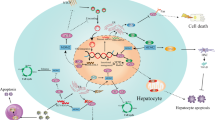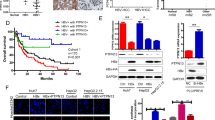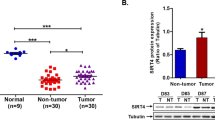Abstract
Infection by hepatitis B virus (HBV) accounts for 50–80% of hepatocellular carcinoma (HCC) development worldwide, in which the HBV-encoded X protein (HBx) has critical role in the induction of carcinogenesis. Several studies have shown that thyroid hormone (TH) suppresses HCC development and protects hepatocytes from HBx-induced damage, thus it is of interest to examine whether TH can protect hepatocytes from HBx-induced carcinogenesis. By treating HBx- transgenic mice with or without TH, we confirmed the protective effects of TH on HBx-induced hepatocarcinogenesis, which was achieved via reduction of reactive oxygen species (ROS) inflicted DNA damage. We further found that TH induced biogenesis of mitochondria (MITO) and autophagy of HBx-targeted MITO simultaneously, consequently leading to suppression of HBx-promoted ROS and carcinogenesis. Using microarray data analysis, this protective effect of TH was found to be mediated via activation of PTEN-induced kinase 1 (PINK1) in hepatocytes. PINK1, in turn, activated and recruited Parkin, an E3 ligase, to ubiquitinate MITO-associated HBx protein and trigger selective mitophagy. The pathological significance of the TH/PINK1 pathway in liver protection was confirmed by the concomitant decrease in expression of both TR and PINK1 in matched HCC tumor tissues and negatively correlated with aggressive progression of cancer and poor prognosis. Our data indicate that TH/PINK1/Parkin pathway has a critical role in protecting hepatocytes from HBx-induced carcinogenesis. Notably, several liver-targeting therapeutic derivatives of TH facilitating prevention or therapy of steatosis have been identified. Furthermore, our proof-of-concept experiments suggest that application of T3 constitutes an effective novel therapeutic or preventive option for HCC. Thus, the utilization of the agonists of TRs could be the meaningful strategy in liver relative diseases, ranging from simple hepatic steatosis to HCC.
This is a preview of subscription content, access via your institution
Access options
Subscribe to this journal
Receive 50 print issues and online access
$259.00 per year
only $5.18 per issue
Buy this article
- Purchase on Springer Link
- Instant access to full article PDF
Prices may be subject to local taxes which are calculated during checkout






Similar content being viewed by others
Abbreviations
- TH:
-
thyroid hormone
- HBx:
-
hepatitis B virus X
- TR:
-
thyroid hormone receptor
- MITO:
-
mitochondria
- PINK1:
-
PTEN-induced kinase 1
- OXPHOS:
-
oxidative phosphorylation
- ROS:
-
reactive oxygen species
- NRFs:
-
nuclear respiratory factors
- Δψm:
-
mitochondrial membrane potential
- OMM:
-
outer mitochondrial membrane
- HBV:
-
hepatitis B virus
- HCC:
-
hepatocellular carcinoma
- γ-H2AX:
-
phospho-histone H2AX
- OCR:
-
oxygen consumption rate
- PPARs:
-
peroxisome proliferator-activated receptors
- CQ:
-
chloroquine.
References
Nguyen VT, Law MG, Dore GJ . Hepatitis B-related hepatocellular carcinoma: epidemiological characteristics and disease burden. J Viral Hepat 2009; 16: 453–463.
Kremsdorf D, Soussan P, Paterlini-Brechot P, Brechot C . Hepatitis B virus-related hepatocellular carcinoma: paradigms for viral-related human carcinogenesis. Oncogene 2006; 25: 3823–3833.
Lee YI, Hwang JM, Im JH, Kim NS, Kim DG, Yu DY et al. Human hepatitis B virus-X protein alters mitochondrial function and physiology in human liver cells. J Biol Chem 2004; 279: 15460–15471.
Malhi H, Gores GJ . Cellular and molecular mechanisms of liver injury. Gastroenterology 2008; 134: 1641–1654.
Shirakata Y, Koike K . Hepatitis B virus X protein induces cell death by causing loss of mitochondrial membrane potential. J Biol Chem 2003; 278: 22071–22078.
Cheng SY, Leonard JL, Davis PJ . Molecular aspects of thyroid hormone actions. Endocr Rev 2010; 31: 139–170.
Harper ME, Seifert EL . Thyroid hormone effects on mitochondrial energetics. Thyroid 2008; 18: 145–156.
Lin YH, Huang YH, Wu MH, Wu SM, Chi HC, Liao CJ et al. Thyroid hormone suppresses cell proliferation through endoglin-mediated promotion of p21 stability. Oncogene 2013; 32: 3904–3914.
Barlow C, Meister B, Lardelli M, Lendahl U, Vennstrom B . Thyroid abnormalities and hepatocellular carcinoma in mice transgenic for v-erbA. EMBO J 1994; 13: 4241–4250.
Sap J, Munoz A, Damm K, Goldberg Y, Ghysdael J, Leutz A et al. The c-erb-A protein is a high-affinity receptor for thyroid hormone. Nature 1986; 324: 635–640.
Frau C, Loi R, Petrelli A, Perra A, Menegon S, Kowalik MA et al. Local hypothyroidism favors the progression of preneoplastic lesions to hepatocellular carcinoma in rats. Hepatology 2015; 61: 249–259.
Hassan MM, Kaseb A, Li D, Patt YZ, Vauthey JN, Thomas MB et al. Association between hypothyroidism and hepatocellular carcinoma: a case-control study in the United States. Hepatology 2009; 49: 1563–1570.
Hunter J, Kassam A, Winrow CJ, Rachubinski RA, Capone JP . Crosstalk between the thyroid hormone and peroxisome proliferator-activated receptors in regulating peroxisome proliferator-responsive genes. Mol Cell Endocrinol 1996; 116: 213–221.
Weitzel JM, Iwen KA . Coordination of mitochondrial biogenesis by thyroid hormone. Mol Cell Endocrinol 2011; 342: 1–7.
Gross NJ . Control of mitochondrial turnover under the influence of thyroid hormone. J Cell Biol 1971; 48: 29–40.
Sinha RA, Singh BK, Zhou J, Wu Y, Farah BL, Ohba K et al. Thyroid hormone induction of mitochondrial activity is coupled to mitophagy via ROS-AMPK-ULK1 signaling. Autophagy 2015; 11: 1341–1357.
Saraste M . Oxidative phosphorylation at the fin de siecle. Science 1999; 283: 1488–1493.
Dawson TL, Gores GJ, Nieminen AL, Herman B, Lemasters JJ . Mitochondria as a source of reactive oxygen species during reductive stress in rat hepatocytes. Am J Physiol 1993; 264: C961–C967.
Gores GJ, Flarsheim CE, Dawson TL, Nieminen AL, Herman B, Lemasters JJ . Swelling, reductive stress, and cell death during chemical hypoxia in hepatocytes. Am J Physiol 1989; 257: C347–C354.
Seo AY, Joseph AM, Dutta D, Hwang JC, Aris JP, Leeuwenburgh C . New insights into the role of mitochondria in aging: mitochondrial dynamics and more. J Cell Sci 2010; 123: 2533–2542.
Youle RJ, Narendra DP . Mechanisms of mitophagy. Nat Rev Mol Cell Biol 2011; 12: 9–14.
Matsuda N, Sato S, Shiba K, Okatsu K, Saisho K, Gautier CA et al. PINK1 stabilized by mitochondrial depolarization recruits Parkin to damaged mitochondria and activates latent Parkin for mitophagy. J Cell Biol 2010; 189: 211–221.
Narendra DP, Jin SM, Tanaka A, Suen DF, Gautier CA, Shen J et al. PINK1 is selectively stabilized on impaired mitochondria to activate Parkin. PLoS Biol 2010; 8: e1000298.
Vives-Bauza C, Zhou C, Huang Y, Cui M, de Vries RL, Kim J et al. PINK1-dependent recruitment of Parkin to mitochondria in mitophagy. Proc Natl Acad Sci USA 2010; 107: 378–383.
Mansour-Ghanaei F, Mehrdad M, Mortazavi S, Joukar F, Khak M, Atrkar-Roushan Z . Decreased serum total T3 level in hepatitis B and C related cirrhosis by severity of liver damage. Ann Hepatol 2012; 11: 667–671.
Wu BK, Li CC, Chen HJ, Chang JL, Jeng KS, Chou CK et al. Blocking of G1/S transition and cell death in the regenerating liver of Hepatitis B virus X protein transgenic mice. Biochem Biophys Res Commun 2006; 340: 916–928.
Kekule AS, Lauer U, Weiss L, Luber B, Hofschneider PH . Hepatitis B virus transactivator HBx uses a tumour promoter signalling pathway. Nature 1993; 361: 742–745.
Rahmani Z, Huh KW, Lasher R, Siddiqui A . Hepatitis B virus X protein colocalizes to mitochondria with a human voltage-dependent anion channel, HVDAC3, and alters its transmembrane potential. J Virol 2000; 74: 2840–2846.
Takada S, Shirakata Y, Kaneniwa N, Koike K . Association of hepatitis B virus X protein with mitochondria causes mitochondrial aggregation at the nuclear periphery, leading to cell death. Oncogene 1999; 18: 6965–6973.
Waris G, Huh KW, Siddiqui A . Mitochondrially associated hepatitis B virus X protein constitutively activates transcription factors STAT-3 and NF-kappa B via oxidative stress. Mol Cell Biol 2001; 21: 7721–7730.
Turrens JF . Mitochondrial formation of reactive oxygen species. J Physiol 2003; 552: 335–344.
Sullivan LB, Chandel NS . Mitochondrial reactive oxygen species and cancer. Cancer Metab 2014; 2: 17.
Sinha RA, You SH, Zhou J, Siddique MM, Bay BH, Zhu X et al. Thyroid hormone stimulates hepatic lipid catabolism via activation of autophagy. J Clin Invest 2012; 122: 2428–2438.
Tseng YH, Ke PY, Liao CJ, Wu SM, Chi HC, Tsai CY et al. Chromosome 19 open reading frame 80 is upregulated by thyroid hormone and modulates autophagy and lipid metabolism. Autophagy 2014; 10: 20–31.
Kim SJ, Khan M, Quan J, Till A, Subramani S, Siddiqui A . Hepatitis B virus disrupts mitochondrial dynamics: induces fission and mitophagy to attenuate apoptosis. PLoS Pathog 2013; 9: e1003722.
Klionsky DJ, Abdelmohsen K, Abe A, Abedin MJ, Abeliovich H, Acevedo Arozena A et al. Guidelines for the use and interpretation of assays for monitoring autophagy (3rd edition). Autophagy 2016; 12: 1–222.
Roessler S, Jia HL, Budhu A, Forgues M, Ye QH, Lee JS et al. A unique metastasis gene signature enables prediction of tumor relapse in early-stage hepatocellular carcinoma patients. Cancer Res 2010; 70: 10202–10212.
Ma NF, Lau SH, Hu L, Xie D, Wu J, Yang J et al. COOH-terminal truncated HBV X protein plays key role in hepatocarcinogenesis. Clin Cancer Res 2008; 14: 5061–5068.
Sze KM, Chu GK, Lee JM, Ng IO . C-terminal truncated hepatitis B virus x protein is associated with metastasis and enhances invasiveness by C-Jun/matrix metalloproteinase protein 10 activation in hepatocellular carcinoma. Hepatology 2013; 57: 131–139.
Gentric G, Desdouets C, Celton-Morizur S . Hepatocytes polyploidization and cell cycle control in liver physiopathology. Int J Hepatol 2012; 2012: 282430.
Lee S, Kim JS . Mitophagy: therapeutic potentials for liver disease and beyond. Toxicol Res 2014; 30: 243–250.
Dias V, Junn E, Mouradian MM . The role of oxidative stress in Parkinson's disease. J Parkinsons Dis 2013; 3: 461–491.
Calvisi DF, Ladu S, Gorden A, Farina M, Conner EA, Lee JS et al. Ubiquitous activation of Ras and Jak/Stat pathways in human HCC. Gastroenterology 2006; 130: 1117–1128.
Jiang T, Liu M, Wu J, Shi Y . Structural and biochemical analysis of Bcl-2 interaction with the hepatitis B virus protein HBx. Proc Natl Acad Sci USA 2016; 113: 2074–2079.
Kim HJ, Kim SY, Kim J, Lee H, Choi M, Kim JK et al. Hepatitis B virus X protein induces apoptosis by enhancing translocation of Bax to mitochondria. IUBMB Life 2008; 60: 473–480.
Clippinger AJ, Bouchard MJ . Hepatitis B virus HBx protein localizes to mitochondria in primary rat hepatocytes and modulates mitochondrial membrane potential. J Virol 2008; 82: 6798–6811.
Terradillos O, de La Coste A, Pollicino T, Neuveut C, Sitterlin D, Lecoeur H et al. The hepatitis B virus X protein abrogates Bcl-2-mediated protection against Fas apoptosis in the liver. Oncogene 2002; 21: 377–386.
Columbano A, Shinozuka H . Liver regeneration versus direct hyperplasia. FASEB J 1996; 10: 1118–1128.
Farber E . Hepatocyte proliferation in stepwise development of experimental liver cell cancer. Dig Dis Sci 1991; 36: 973–978.
Preston-Martin S, Pike MC, Ross RK, Jones PA, Henderson BE . Increased cell division as a cause of human cancer. Cancer Res 1990; 50: 7415–7421.
Perra A, Simbula G, Simbula M, Pibiri M, Kowalik MA, Sulas P et al. Thyroid hormone (T3) and TRbeta agonist GC-1 inhibit/reverse nonalcoholic fatty liver in rats. FASEB J 2008; 22: 2981–2989.
Ledda-Columbano GM, Perra A, Piga R, Pibiri M, Loi R, Shinozuka H et al. Cell proliferation induced by 3,3',5-triiodo-L-thyronine is associated with a reduction in the number of preneoplastic hepatic lesions. Carcinogenesis 1999; 20: 2299–2304.
Ledda-Columbano GM, Perra A, Loi R, Shinozuka H, Columbano A . Cell proliferation induced by triiodothyronine in rat liver is associated with nodule regression and reduction of hepatocellular carcinomas. Cancer Res 2000; 60: 603–609.
Perra A, Kowalik MA, Pibiri M, Ledda-Columbano GM, Columbano A . Thyroid hormone receptor ligands induce regression of rat preneoplastic liver lesions causing their reversion to a differentiated phenotype. Hepatology 2009; 49: 1287–1296.
Chi HC, Chen SL, Liao CJ, Liao CH, Tsai MM, Lin YH et al. Thyroid hormone receptors promote metastasis of human hepatoma cells via regulation of TRAIL. Cell Death Differ 2012; 19: 1802–1814.
Chi HC, Chen SL, Tsai CY, Chuang WY, Huang YH, Tsai MM et al. Thyroid hormone suppresses hepatocarcinogenesis via DAPK2 and SQSTM1-dependent selective autophagy. Autophagy 2016; 12: 2271–2285.
Acknowledgements
This work was supported by grants from Chang Gung Memorial Hospital, Taoyuan, Taiwan (CRRPD1F0011, CRRPD1F0012) and from the Ministry of Science and Technology of the Republic of China (MOST 103-2320-B-182-018-MY3, 103-2320-B-182-017-MY3, 105-2811-B-182-018, 105-2321-B-182-002-MY3). Accession number of transcript profiling: GEO accession: GSE14520.
Author information
Authors and Affiliations
Corresponding author
Ethics declarations
Competing interests
The authors declare no conflict of interest.
Additional information
Supplementary Information accompanies this paper on the Oncogene website
Supplementary information
Rights and permissions
About this article
Cite this article
Chi, HC., Chen, SL., Lin, SL. et al. Thyroid hormone protects hepatocytes from HBx-induced carcinogenesis by enhancing mitochondrial turnover. Oncogene 36, 5274–5284 (2017). https://doi.org/10.1038/onc.2017.136
Received:
Revised:
Accepted:
Published:
Issue Date:
DOI: https://doi.org/10.1038/onc.2017.136
This article is cited by
-
Multi-omics analysis revealed the mitochondrial-targeted drug combination to suppress the development of lung cancer
Journal of Cancer Research and Clinical Oncology (2023)
-
IFITM3 promotes malignant progression, cancer stemness and chemoresistance of gastric cancer by targeting MET/AKT/FOXO3/c-MYC axis
Cell & Bioscience (2022)
-
Cirsiliol regulates mitophagy in colon cancer cells via STAT3 signaling
Cancer Cell International (2022)
-
Effect of prior thyroid cancer on survival of primary liver cancer: a study based on the SEER database
Scientific Reports (2022)
-
Mitophagy in carcinogenesis, drug resistance and anticancer therapeutics
Cancer Cell International (2021)



